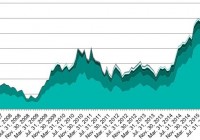Will GLD Keep Losing Its Shine?
Summary The gold market is expected to be pressured down as the U.S. dollar resumes its upward trend and the Fed moves towards raising rates. The focus is shifting towards the Fed’s normalization path. The market estimates only two to three rate hikes next year. Shares of the SPDR Gold Trust ETF (NYSEARCA: GLD ) and price of gold climbed back up last week, in part as the U.S. dollar changed course and fell following the lower than expected rate cut by the ECB. In her recent testimony to Congress, FOMC Chair Yellen signaled the U.S. economy is ready for higher rates. And the last non-farm payroll report , in which 211,000 jobs were added back in November, reaffirmed market expectations for the Fed to raise rates this month. Labor market continues to improve The recent NFP report showed a bit higher than expected growth in number of jobs. Wages rose by 0.2%, month over month and by 2.3% for the year. And while not all figures in the report were good — the real unemployment (U6) edged up to 9.9% — it was still overall good enough to pave the way for a December rate hike. Thus, this jobs report along with Yellen’s testimony should have raised the implied probabilities of a rate hike but for now the odds are at 79% — little changed from the previous week. The problem with raising rates at this stage is that the core inflation is still low. And it will be even harder for inflation to rise as the Fed’s cash rates moves up. Nonetheless, as the Fed moves towards raising rates in the next meeting, the price of GLD could resume, even if over the short term, its downward trend. And once the FOMC raises rates this month, the median outlook the Fed targeted in September will be met, as indicated in the table below. Source: Fed’s website Even though the labor market is doing well enough to prompt the Fed to raise rates this month, this week the JOLTS report will provide another perspective about the progress of the labor market. The recent depreciation of the U.S. dollar, mainly against the Euro, came after the ECB didn’t introduce stimulus as the market expected. The recent break we had from the rally of the U.S. dollar has helped pull back up GLD. And the U.S. dollar is expected to resume its rally, which will keep pressuring down GLD. Looking beyond the upcoming rate hike, and assuming the Fed moves forward and raises rates this month, the outlook for the future hikes suggest only a few rate raises in 2016. If rates were to rise at a slower pace than previously expected, this could hold the price of GLD from falling next year. (click to enlarge) Source: Fed-Watch The table above shows the implied probabilities over the next FOMC meetings 2015-2016. Based on these figures, the market expects the target rate to reach 0.84% by the end of 2016 – over 0.5 percentage point lower than the FOMC’s median outlook of 1.375%. Based on the Fed-watch outlook, this implies two rate hikes next year of 0.25% (again, assuming the Fed were to raise rates this year). If this outlook will coincide with FOMC members’ estimates, then the Fed will revise down its projections in the next meeting. And downward revisions could partly offset the expected adverse impact the rate hike will have on GLD. If rates were to remain lower than currently expected next year, the downward pressure on GLD will be less intense. Bottom line The gold market isn’t expected to shine or see rising prices anytime soon, especially as the Fed moves towards raising rates in December and U.S. dollar keeps climbing against other currencies. But following the initial rate hike, which is likely to have a short term negative impact on gold prices, it will be more important to see how the Fed plans raising rates in 2016. The current market outlook aims towards only 2 to 3 hikes next year. Lower than previously estimated rates could hold GLD from plummeting, albeit this won’t stop the general downward trend. For more please see: ” Gold and Inflation – Is there is relation? ”
